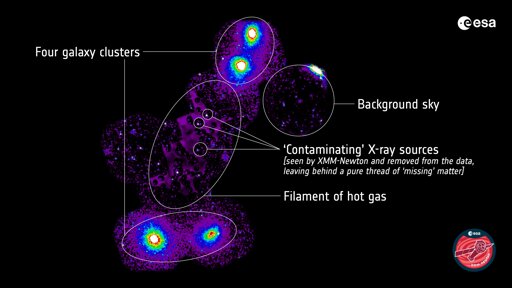
teehee
“The models were right”: Astronomers find ‘missing’ matter
This image shows the new filament, which connects four galaxy clusters: two on one end, two on the other. These clusters are visible as bright spots at the bottom and top of the filament (four white dots encircled by color). A mottled band of purple stretches between these bright dots, standing out brightly against the black surrounding sky; this is the filament of X-ray-emitting hot gas that had not been seen before, and contains a chunk of ‘missing’ matter. The purple band comprises data from Suzaku. The astronomers were able to identify and remove any possible ‘contaminating’ sources of X-rays from the filament using XMM-Newton, leaving behind a pure thread of ‘missing’ matter. These sources can be seen here as bright dots studded through—and removed from—the filament’s emission. Credit: ESA/XMM-Newton and ISAS/JAXA
Astronomers have discovered a huge filament of hot gas bridging four galaxy clusters. At 10 times as massive as our galaxy, the thread could contain some of the universe’s ‘missing’ matter, addressing a decades-long mystery.
The astronomers used the European Space Agency’s XMM-Newton and JAXA’s Suzaku X-ray space telescopes to make the discovery.
The work has been published in Astronomy and Astrophysics.
Over one-third of the ‘normal’ matter in the local universe—the visible stuff making up stars, planets, galaxies, life—is missing. It hasn’t yet been seen, but it’s needed to make our models of the cosmos work properly.
Said models suggest that this elusive matter might exist in long strings of gas, or filaments, bridging the densest pockets of space. While we’ve spotted filaments before, it’s tricky to make out their properties; they’re typically faint, making it difficult to isolate their light from that of any galaxies, black holes, and other objects lying nearby.
New research is now one of the first to do just this, finding and accurately characterizing a single filament of hot gas stretching between four clusters of galaxies in the nearby universe.
“For the first time, our results closely match what we see in our leading model of the cosmos—something that’s not happened before,” says lead researcher Konstantinos Migkas of Leiden Observatory in the Netherlands. “It seems that the simulations were right all along.”
“The models were right”: Astronomers find ‘missing’ matter A simulation of the ‘cosmic web’, the vast network of threads and filaments that extends throughout the universe. Stars, galaxies, and galaxy clusters spring to life in the densest knots of this web, and remain connected by vast threads that stretch out for many millions of light-years. These threads are invisible to the eye, but can be uncovered by telescopes such as ESA’s XMM-Newto. Credit: Illustris Collaboration / Illustris Simulation
XMM-Newton on the case Clocking in at over 10 million degrees, the filament contains around 10 times the mass of the Milky Way and connects four galaxy clusters: two on one end, two on the other. All are part of the Shapley Supercluster, a collection of more than 8,000 galaxies that forms one of the most massive structures in the nearby universe.
The filament stretches diagonally away from us through the supercluster for 23 million light-years, the equivalent of traversing the Milky Way end to end around 230 times.
Konstantinos and colleagues characterized the filament by combining X-ray observations from XMM-Newton and Suzaku, and digging into optical data from several others.
The two X-ray telescopes were ideal partners. Suzaku mapped the filament’s faint X-ray light over a wide region of space, while XMM-Newton pinpointed very precisely contaminating sources of X-rays—namely, supermassive black holes—lying within the filament.
“Thanks to XMM-Newton we could identify and remove these cosmic contaminants, so we knew we were looking at the gas in the filament and nothing else,” adds co-author Florian Pacaud of the University of Bonn, Germany. “Our approach was really successful, and reveals that the filament is exactly as we’d expect from our best large-scale simulations of the universe.”
“The models were right”: Astronomers find ‘missing’ matter This image shows the new filament, which connects four galaxy clusters: two on one end, two on the other. These clusters are visible as bright spots at the bottom and top of the filament (four white dots encircled by color). A mottled band of purple stretches between these bright dots, standing out brightly against the black surrounding sky; this is the filament of X-ray-emitting hot gas that had not been seen before, and contains a chunk of ‘missing’ matter. The purple band comprises data from Suzaku. The astronomers were able to identify and remove any possible ‘contaminating’ sources of X-rays from the filament using XMM-Newton, leaving behind a pure thread of ‘missing’ matter. These sources can be seen here as bright dots studded through—and removed from—the filament’s emission. Credit: ESA/XMM-Newton and ISAS/JAXA
Not truly missing As well as revealing a huge and previously unseen thread of matter running through the nearby cosmos, the finding shows how some of the densest and most extreme structures in the universe—galaxy clusters—are connected over colossal distances.
It also sheds light on the very nature of the ‘cosmic web’, the vast, invisible cobweb of filaments that underpins the structure of everything we see around us.
“This research is a great example of collaboration between telescopes, and creates a new benchmark for how to spot the light coming from the faint filaments of the cosmic web,” adds Norbert Schartel, ESA XMM-Newton Project Scientist.
“More fundamentally, it reinforces our standard model of the cosmos and validates decades of simulations: it seems that the ‘missing’ matter may truly be lurking in hard-to-see threads woven across the universe.”
Piecing together an accurate picture of the cosmic web is the domain of ESA’s Euclid mission. Launched in 2023, Euclid is exploring this web’s structure and history.
The mission is also digging deep into the nature of dark matter and energy—neither of which have ever been observed, despite accounting for a whopping 95% of the universe—and working with other dark universe detectives to solve some of the biggest and longest-standing cosmic mysteries
So that’s dark matter explained, what about dark energy?
It’s not dark matter, it’s normal (baryonic) matter that we hadn’t found a way to see yet. Dark matter doesn’t interact with light at all, so we only detect its gravitational effects.
In astronomy, dark matter is an invisible and hypothetical form of matter that does not interact with light or other electromagnetic radiation. Dark matter is implied by gravitational effects that cannot be explained by general relativity unless more matter is present than can be observed.
Dark matter was posited, in part, because we couldn’t explain how galaxies don’t fling apart due to the rotational forces. Since we observed the effects, but couldn’t see nor detect the cause, we thought something should be there that doesn’t interact with light. However, these findings and that of Caltech show that there isn’t a need for a theoretical matter as normal matter at very low densities will do just fine.
Which leads us back to the question, dafuq is dark energy?
Dark energy is the force believed to drive the expansion of the universe. The distance between galaxies continues to grow and the doesn’t seem to be a good explanation for it yet. It’s the “X” variable acting as a placeholder until that’s answered. Or at least that is my understanding.
After reading the wikipedia article, that basic understanding of it might be correct, but I’m not an astrophysicist.
Dark energy is basically a placeholder name. We have no direct evidence of it, but we indirectly know it has to exist due to other gravitational effects. As soon as we understand what it is the term “dark energy” will probably be replaced with whatever we discover to cause the observables currently attributed to dark energy, as dark energy is basically scientist for “no fucking idea why we observe these effects, but we do observe them”. I’m not currently an astrophysicist but I spent time during undergrad as a research assistant on a LIGO project
So it’s unrelated to this?




